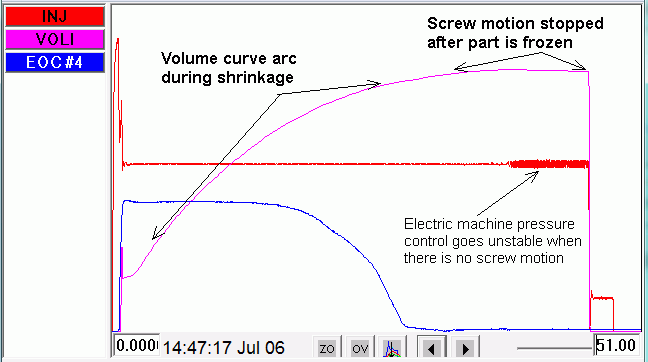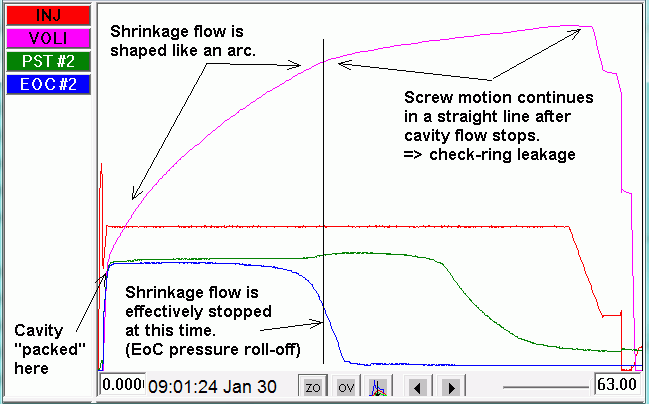Tip of the Day 179: Volume Curves: Shrinkage or Leakage?
In tip #178 you saw how the screw moves forward as a thick, semi-crystalline part continues to shrink after “packing”. The action of this shrinkage can be studied by making the volume curve scale larger to see the detail after the cavity pressures reach their peaks.

The crystallization of the melt in the cavity allows the screw to move at an ever decelerating rate until the cavity freezes. The curve looks like an arc because the molten core in the part continues to get smaller as the walls thicken, reducing the flow rate throughout the shrinkage phase. Think of the slope of the volume curve as the flow rate. A steep slope is faster flow. A horizontal line indicates no flow. When the part has “frozen”, the volume curve flat-lines showing that the screw has stopped.
Consider the following process where the screw does not stop at the freeze time.

Here the screw continues to move forward after the part is no longer accepting material during crystallization. If the material did not go into the cavity, where did it material go?
Through the check ring‡. In fact, if left long enough the screw will go all the way to bottom.
Take-away:
If the screw continues to move after the part (or cold sprue) is solid, then the check ring is leaking. Leaking screw movement usually appears a straight line on the volume curve instead of the arc that you see during the shrinkage phase.
Aside:
For those curious about the rise in post gate pressure after the EoC cools, see tip #146.
Technical Notes
The fluid flow equations tell us that, with a fixed pressure, flow is proportional to pressure, viscosity and the size of the flow channel.

Since there is no flow into the cavity after freezing, the only place for the material to go is back through the check-ring. If the check ring has a crack or does not seal, it forms a flow “channel” of a fixed size.† Since the size of the channel is not changing, the viscosity is constant and the pressure is constant (hold) then the flow is at a constant rate.
This works for amorphous materials as well as semicrystalline in both hot and cold runner, thick-wall molds. In thin-wall, the screw motion during pack is so small that the arc may not be visible. However, if the check-ring is leaking during hold, the screw will still move forward at a constant rate after the cavity or sprue is frozen.
——–
‡ “Check-ring” here is generic for any non-return valve.
† The “D” is the effective diameter, also known as “hydraulic diameter” which is 4A/P.


